2015 AUDI Q5 child restraint
[x] Cancel search: child restraintPage 178 of 302
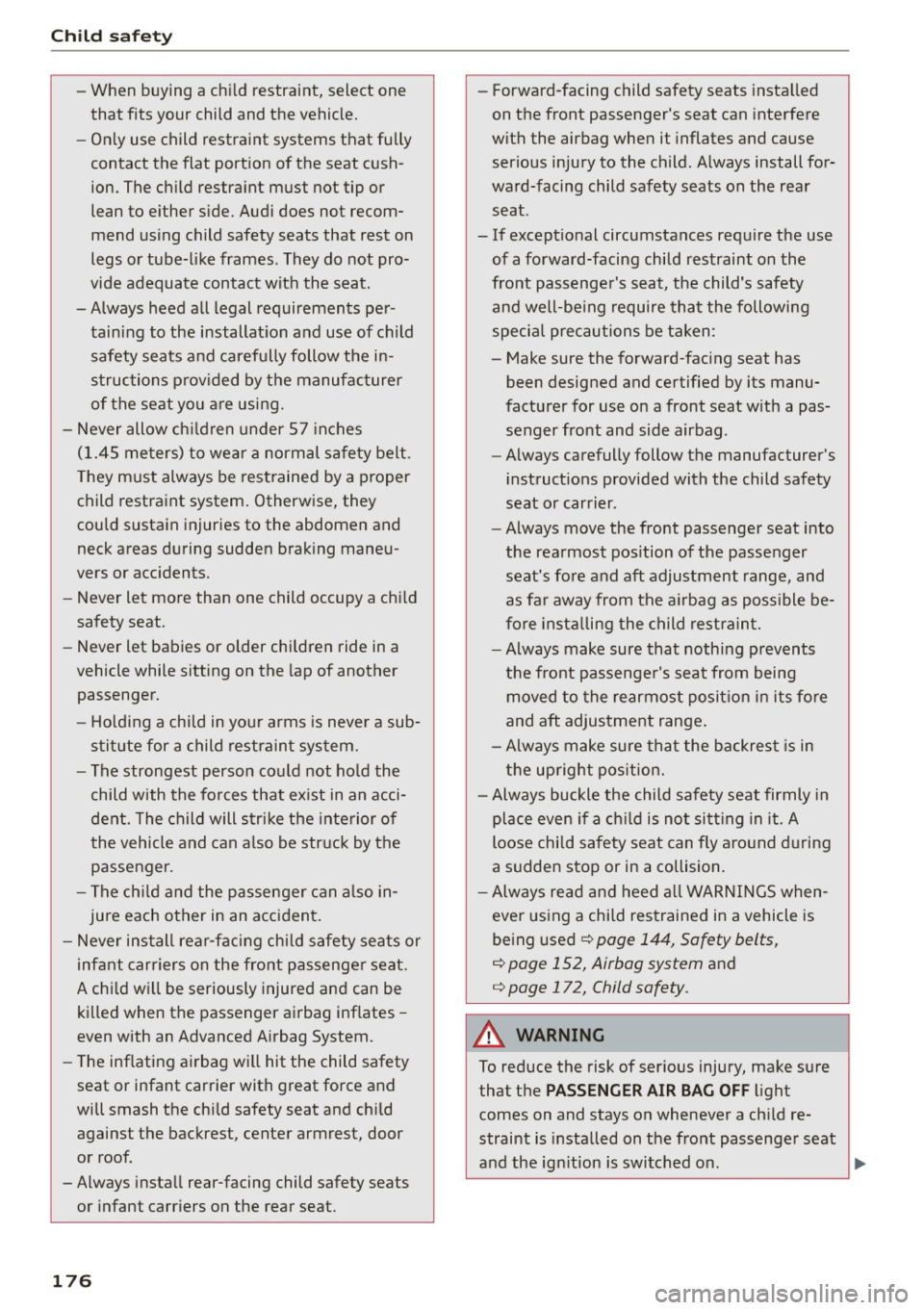
Child safet y
-When b uying a ch ild restraint, select one
that fits your child and the vehicle.
- On ly use child restraint systems that fully
contact the flat port ion of the seat cush
ion. The ch ild restra int must not tip or
lean to either s ide. Audi does not recom
mend using child safety seats that rest on
legs o r tube-like frames . They do not pro
vide adequate contact with the seat.
- Always heed all legal requirements pe r
taining to the installat ion and use of ch ild
safety seats and carefully follow the in
struc tions prov ided by the manufacturer
of the seat you are using.
- Never allow ch ildren under 57 inches
(1.45 me ters) to wear a normal sa fety belt .
They m ust always be rest rained by a proper
child restra int system. Otherwise, they
could sustain injuries to the abdomen and
neck areas during sudden braking maneu
vers or acc idents.
- Never let more than one child occupy a chi ld
safety seat.
- Never let babies or older children ride in a
vehicle while sitting on the lap of another
passenger.
- Ho ld ing a child in your arms is neve r a sub
stit ute for a child rest raint sys tem.
- The strongest person co uld not hold the
child with the fo rces that ex ist in an acci
dent. The child will s tri ke the inte rior of
the vehicle and can a lso be str uck by the
passenger.
- The ch ild and the passenger can a lso in
jure each other in an acc ident .
- Never ins tall rear-facing chi ld safety seats or
infant carriers on the front passenger seat.
A ch ild w ill be seriously injured and can be
killed when the passenger airbag inf lates -
even with an Advanced Airbag System .
- The inf lating airbag will hit the child safety
seat or infant carrier with great force and
will smash the chi ld safety seat and child
against the backrest, center armrest, door
o r roof.
-Always insta ll rear-facing child safety seats
or infant carr iers on the rear seat.
176
- Forwa rd-facing child safety seats insta lled
on the front passenger's seat can interfere
w ith the airbag when it inflates and cause
serious injury to the child. Always install fo r
ward-facing child safety seats on the rear seat .
- If except ional circumstances require the use
of a fo rward-facing child restraint on the
front passenge r's seat, the child's safety
and well-be ing require that the following
speci al precautions be taken :
- Make sure the forward-facing seat has
been designed and certified by its manu
factu rer for use on a front seat w ith a pas
senger front and side airbag .
- Always carefully follow the manufacturer's
i nst ructions provided with the child safety
seat or carrier .
- Always move the front passenger seat into
the rea rmost pos ition of the passenger
seat's fore and aft adjustment range, and
as fa r away from the a irbag as poss ible be
fo re insta lling the child rest raint.
- Always make sure that nothing p revents
the front passenge r's seat from being
moved to the rearmost posit ion in its fo re
and aft adjustment range .
- Always make sure tha t the backres t is in
the up right pos ition.
- Always buckle the child sa fety seat firmly in
place even if a ch ild is not si tting in it. A
loose child safety seat can fly around d uring
a sudden stop or in a collision.
- Always read and heed a ll WARNI NGS when
eve r us ing a child restrained in a vehicle is
be ing used
¢ page 144, Safety belts,
¢ page 152, Airbag system and
¢ page 172 , Child safety.
A WARNING
To reduce the risk of ser ious injury, make sure
that the
PASSENGER AIR BAG OFF li ght
comes on and stays on whenever a ch ild re
straint is installed on the front passenge r seat
and the ign ition is switched on . ..,.
Page 179 of 302
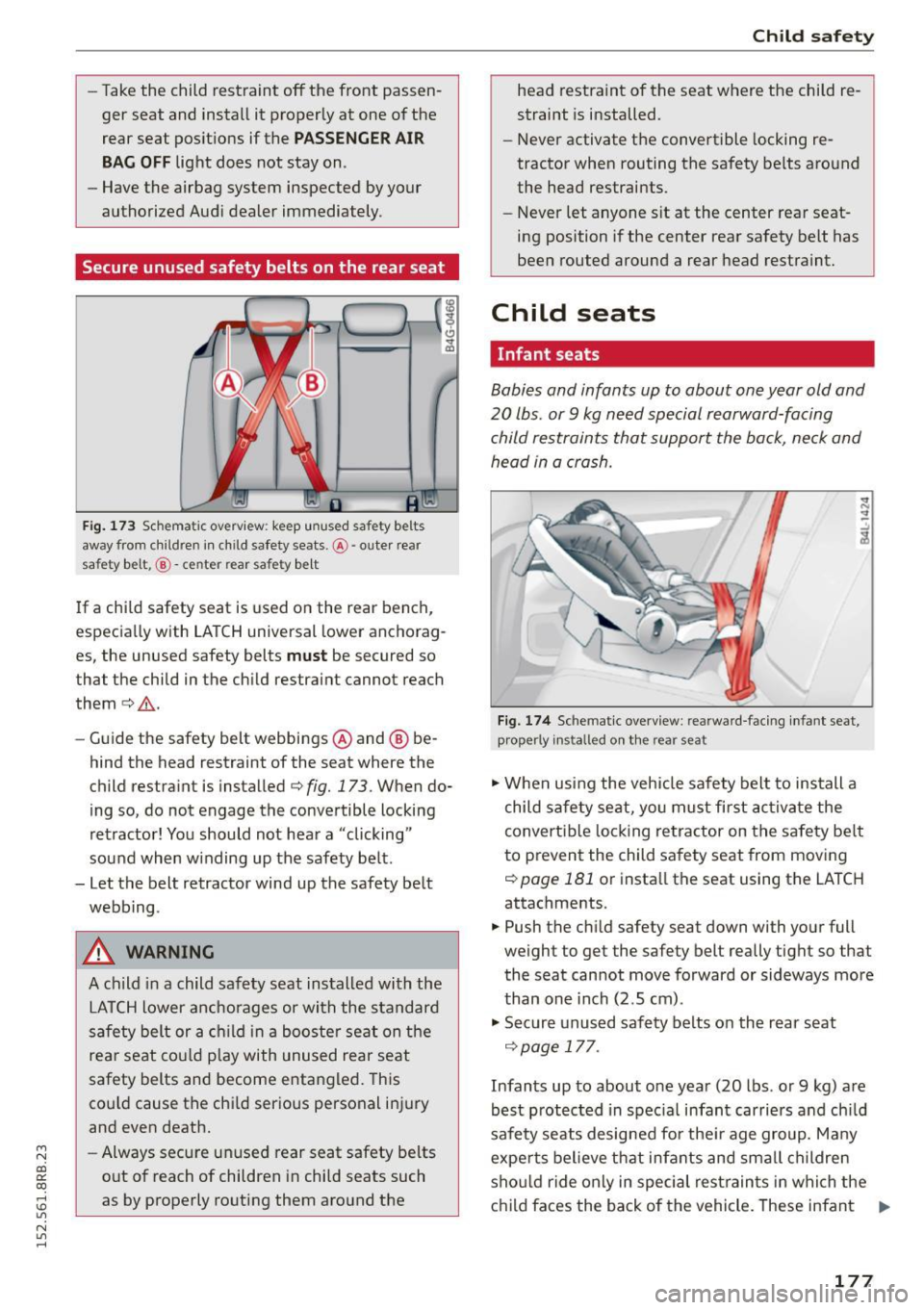
M N
co ~ co
rl I.O
"' N
"' rl
-Take the child restraint off the front passen
ger seat and install it properly at one of the
rear seat pos itions if the
PASSENGER AIR
BA G OFF
light does not stay on.
- Have the airbag system inspected by your
authorized Audi dealer immediately.
Secure unused safety belts on the rear seat
Fig . 173 Schematic overview: keep unused safety belts
away from children in child safety seats. @-oute r rear
safety belt,
@ -center rea r safety belt
If a chi ld safety seat is used on the rear bench ,
especia lly with LATCH universal lower anchorag
es, the unused safety belts
must be secured so
that the child in the child restraint cannot reach
them¢ _&.
- Guide the safety belt webbings @and @ be
hind the head restraint of the seat where the
child restraint is installed¢
fig. 173. When do
ing so, do not engage the convertible locking
retractor! You should not hear a "clicking"
sound when w inding up the safety belt.
- Let the belt retractor wind up the safety belt
webbing .
A WARNING
A child in a child safety seat installed with the
LA TCH lower anchorages or with the standard
safety belt or a ch ild i n a booste r seat on the
rea r seat co uld play with unused rear seat
safety belts and become entangled. This
co uld cause the chi ld serious personal inj ury
and even death.
- Always secure un used rear seat safety belts
o ut of reach of children in child seats such
as by properly routing them around the
Chil d sa fe ty
head restra int of the seat where the child re
straint is installed.
- Never activate the convertible locking re
tractor when routing the safety belts around
the head restraints.
- Never let anyone s it at the center rear seat
ing position if the center rear safety belt has
been routed around a rear head restraint.
Child seats
Infant seats
Babies and infants up to about one year old and
20 lbs . or
9 kg need special rearward-facing
child restraints that support the back, neck and
head in a crash.
F ig. 174 Schemat ic overv iew : rearward -fac ing infant seat,
proper ly installed on th e rear seat
., W hen using the vehicle safety belt to install a
child safe ty seat, yo u must first ac tivate the
convert ib le lock ing retractor on the safety be lt
to prevent the child sa fety seat from mov ing
i=:> page 181 or insta ll the seat using the LATCH
attachments.
.. Push the child safety seat down with your full
weight to get the safety belt really tight so that
the seat cannot move forward or sideways more
than one inch (2.5 cm).
., Secure unused safety belts on the rear seat
¢page 177.
Infants up to about one year (20 lbs. or 9 kg) are
best p rotected in spec ial infant carriers and ch ild
safety seats designed for the ir age group. Many
expe rts bel ieve that infants and sma ll children
sho uld ride only in special restrain ts in which the
child faces the back of the vehicle. These infant .,.
177
Page 180 of 302
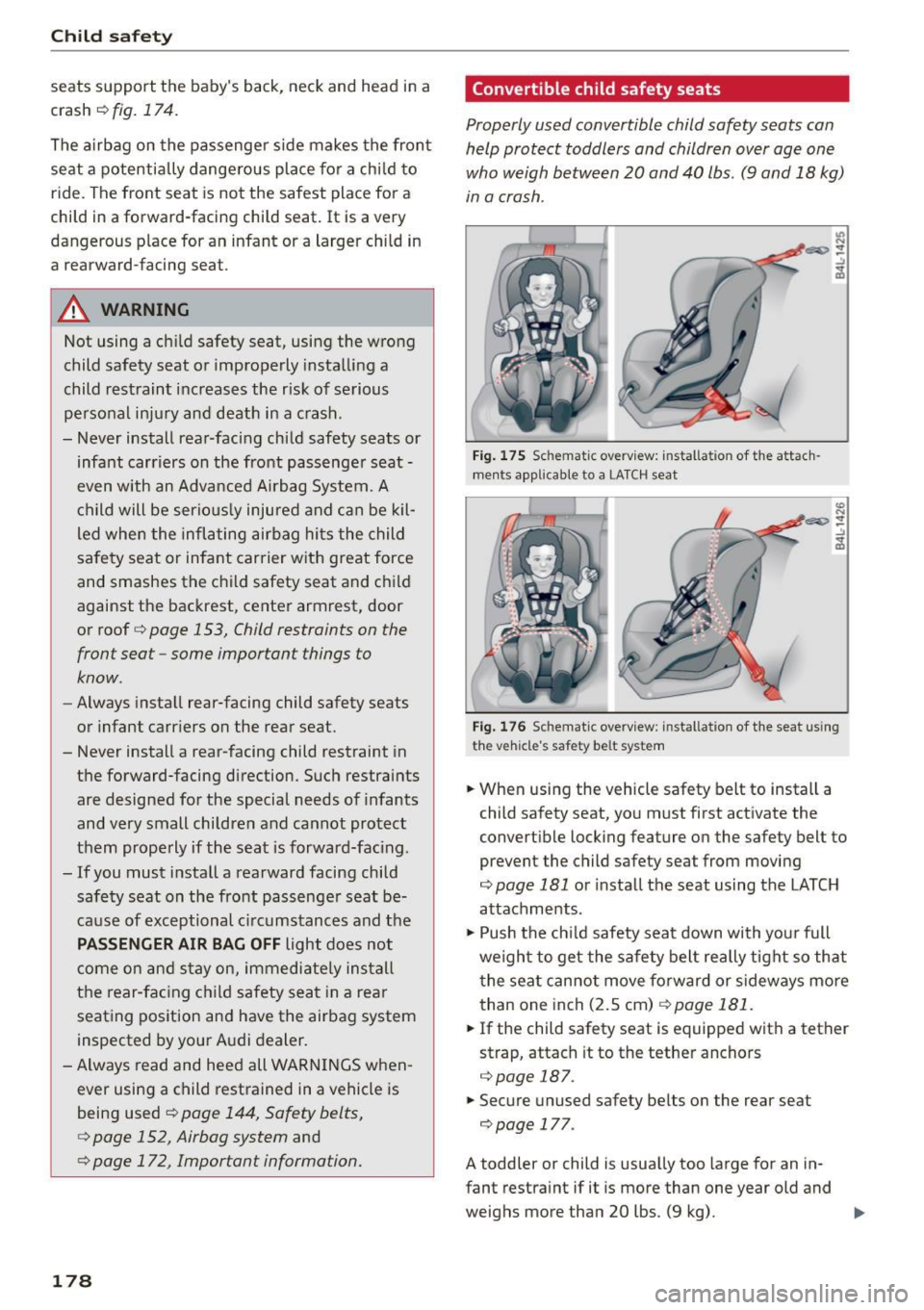
Child safety
seats support t he baby 's back, neck and head in a
crash
r=> fig . 174.
The airbag on the passenger side makes the fron t
seat a potentially dange rous place for a ch ild to
ride. The front seat is not the safest place for a
child in a fo rward-facing child seat. It is a very
dangerous p lace for an infant or a larger chi ld in
a rearward-facing seat .
_&. WARNING
Not using a child safety seat , using the wrong
child safety seat o r imp roperly insta lling a
child restraint inc reases the r isk of serious
personal in ju ry and death in a crash .
- Never install rea r-facing ch ild safety seats or
infant carriers on the front passenger seat -
even w ith an Advanced Ai rbag System. A
c hild will be serio us ly injured and c an be kil
led whe n the infl ating airbag hits the child
sa fe ty seat or infant carrier w ith great force
and smashes the c hild safety seat and c hild
against the bac krest, center armrest, door
or roof
r=> page 153, Child restraints on the
front seat -some important things to
know .
-Always insta ll rear-facing child safety seats
o r infant ca rr iers on the rear seat.
- Never install a rear-facing child restraint in the forward-facing direction. Such restra ints
are designed for the specia l needs of infants
and very small children and cannot protect
them prope rly if the seat is forward-fac ing .
- If you must install a rearward facing child safety seat on the front pass enge r seat be
ca use of exceptional c ircumstanc es and t he
PASSENGER AIR BAG OFF light does not
c ome on an d st ay on, immedi ate ly ins tall
t h e rear-facing c hild safety sea t in a rea r
seat ing position and have the airbag system
inspected by your Audi dealer.
- Alw ays read and hee d all WARN INGS when
ever using a child restrained in a vehicle is
being used
c::> page 144 , Safety belts,
c::> page 152, Airbag system
and
c::> page 172, Important information.
178
Convertible child safety seats
Properly used convertible child safety seats can
help protect toddlers and children over age one
who weigh between 20 and 40 lbs. (9 and 18 kg)
in a cra sh .
Fi g. 175 Sc hem at ic ove rv iew: instal la ti on of t he attach
m ents applicable to a LA T CH seat
Fi g. 1 76 Schemat ic ove rv iew : in stal lat io n of th e seat usin g
the v ehicl e's sa fet y bel t system
.. When using the vehicle safety belt to install a
child sa fety seat, you must first activate the
convertible locking feature on the safety belt to
prevent the child safety seat from moving
r=> page 181 or i nsta ll the seat using the LATC H
attachments.
.,. Push the ch ild safety seat down with you r full
weigh t to get the safe ty belt rea lly tight so that
t he sea t ca nnot move forward or sideways mo re
than one inch (2.5 cm)
r=> page 181.
.. If the child safety seat is equipped with a tether
strap, attach it to the tether anchors
c::> page 187.
.. Secure unused safety belts on the rear seat
r=> page 177 .
A toddler or child is usua lly too large for an in
fant restra int if it is more than one year old and
weighs more than 20 lbs . (9 kg) .
IJJ,,
Page 181 of 302
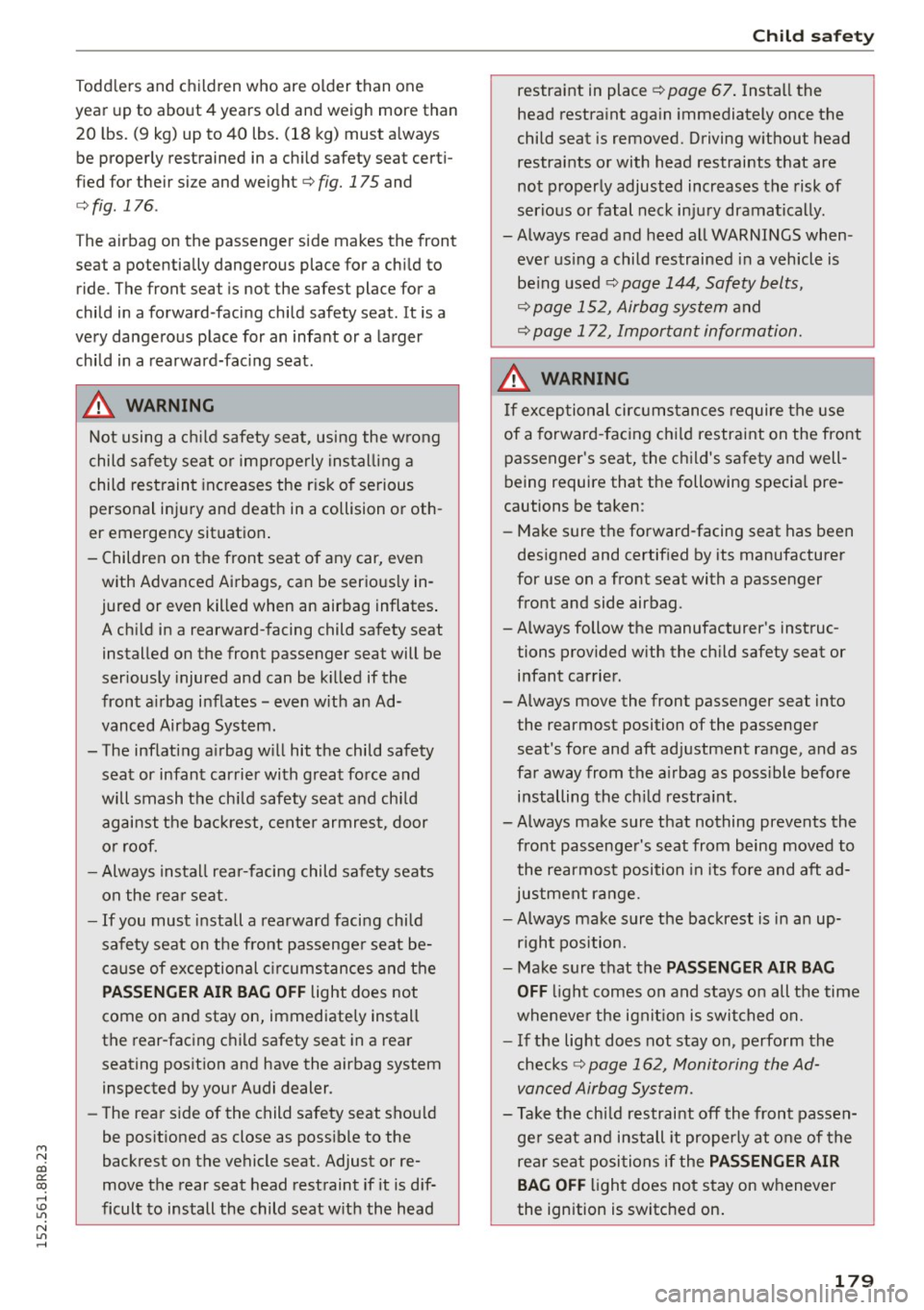
M N
co
a:
co
,...., \!) 1.1'1
N 1.1'1 ,....,
Toddlers and children who are older than one
year up to about 4 years old and weigh more than
20 lbs. (9 kg) up to 40 lbs. (18 kg) must always
be properly restrained in a child safety seat certi
fied for their si ze and weight¢
fig. 175 and
¢fig. 176 .
The airbag on the passenger side makes the front
seat a potentially dangerous place for a child to ride . The front seat is not the safest place for a
child in a forward-facing child safety seat. It is a
very dangerous place for an infant or a larger
child in a rearward-facing seat.
.8, WARNING
Not using a child safety seat, using the wrong
child safety seat or improperly installing a
child restraint increases the risk of serious
personal injury and death in a collision or oth
er emergency situation.
- Children on the front seat of any car, even
with Advanced Airbags, can be seriously in
jured or even killed when an airbag inflates. A child in a rearward-facing child safety seat
installed on the front passenger seat will be
seriously injured and can be killed if the
front airbag inflates -even with an Ad·
vanced Airbag System .
- The inflating airbag will hit the child safety seat or infant carrier with great force and
will smash the child safety seat and child against the backrest, center armrest, door
or roof.
- Always install rear-facing child safety seats
on the rear seat.
- If you must install a rearward facing child
safety seat on the front passenger seat be
cause of exceptional circumstances and the
PASSENGER AIR BAG OFF light does not
come on and stay on, immediately install
the rear-facing child safety seat in a rear
seating position and have the airbag system inspected by your Audi dealer.
- The rear side of the child safety seat should
be positioned as close as possible to the
backrest on the vehicle seat. Adjust or re
move the rear seat head restraint if it is dif
ficult to install the child seat with the head
Child safety
restraint in place ¢page 67. Install the
head restraint again immediately once the
child seat is removed. Driving without head restraints or with head restraints that are
not properly adjusted increases the risk of
serious or fatal neck injury dramatically.
- Always read and heed all WARNINGS when
ever using a child restrained in a vehicle is
being used¢
page 144, Safety belts,
¢ page 152, Airbag system
and
¢ page 172, Important information.
.8, WARNING
If exceptional circumstances require the use
of a forward-facing child restraint on the front
passenger's seat, the child's safety and well
being require that the following special pre
cautions be taken:
- Make sure the forward-facing seat has been
designed and certified by its manufacturer
for use on a front seat with a passenger
front and side airbag .
- Always follow the manufacturer's instruc
tions provided with the child safety seat or
infant carrier.
-Always move the front passenger seat into the rearmost position of the passenger seat's fore and aft adjustment range, and as
far away from the airbag as possible before installing the child restraint.
- Always make sure that nothing prevents the
front passenger's seat from being moved to the rearmost position in its fore and aft ad
justment range.
- Always make sure the backrest is in an up
right position.
- Make sure that the
PASSENGER AIR BAG
OFF
light comes on and stays on all the time
whenever the ignition is switched on.
- If the light does not stay on, perform the
checks ¢
page 162, Monitoring the Ad
vanced Airbag System.
- Take the child restraint off the front passen
ger seat and install it properly at one of the
rear seat positions if the
PASSENGER AIR
BAG OFF
light does not stay on whenever
the ignition is switched on.
179
Page 183 of 302
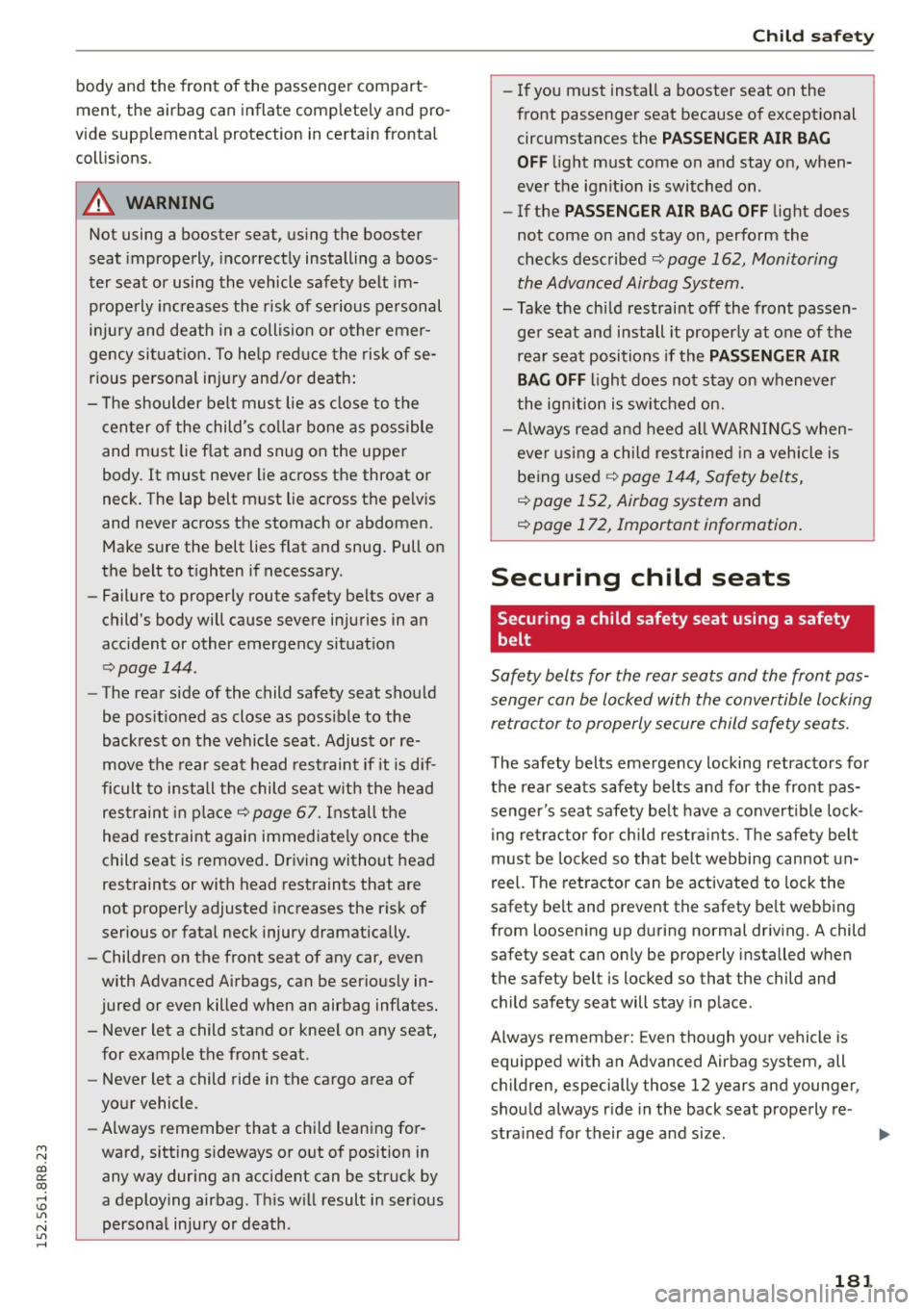
M N
co
a:
co
,...., \!) ..,.,
N ..,., ,....,
body and the front of the passenger compart
ment, the airbag can inflate comp letely and pro
vide supp lemental protection in certain frontal
coll is ions .
& WARNING
Not using a booster seat, us ing the booster
seat imprope rly, incorrect ly installing a boos
ter seat or using the vehicle safety belt im prope rly increases the r isk of se rious personal
injury and death in a collision or other emer
gency sit uat ion. To he lp reduce the risk of se
r ious personal inju ry and/or death:
- T he shoulder be lt mus t lie as close to the
c en ter o f the child's co llar bone as possible
and must lie f lat and snug on the uppe r
body.
It must never lie across the throat o r
neck . The lap belt m ust lie across the pelv is
and never across the stomach or abdomen.
Make sure the belt lies flat and snug. Pull on
the belt to t ighten if necessary.
- Failure to properly route safety belts over a
child's body will cause severe in juries in an
acc ident or other emergency situat ion
~ page 144.
-The rea r side of the child safety seat shou ld
be pos it ioned as close as poss ible to the
backrest on the vehicle seat . Adjust or re
move the rear seat head rest raint if it is d if
ficult to install the child seat w ith the he ad
res traint in p lace
~ page 67. Inst all the
head restraint again immed iate ly once the
child seat is removed . Dr iv ing without head
restraints or with head rest raints that are
not prope rly adjusted inc reases the r isk o f
serious or fatal neck injury dramatically.
- Children on the front seat of any car, even
with Advanced Airbags, can be ser ious ly in
jured or even killed when an airbag inflates.
- Never let a child stand or knee l on any seat,
for example the front seat.
- Never let a child ride in the cargo area of
yo ur vehicle.
- Always remember that a chi ld lean ing fo r
ward, sitting s ideways or o ut o f pos ition in
any way dur ing an accident can be struck by
a deploying airbag. Th is w ill result in ser ious
persona l inju ry or death .
Child sa fety
- If you must install a booster seat on the
front passenge r seat because o f exceptional
circumstances the
PASSENGER AIR BAG
OFF
li ght must come on and stay on, when
eve r the ignit ion is switched o n.
- If the
PASSENGER AIR BAG OFF light does
not come on and stay on, perform the
checks desc ribed
~ page 162, Monitoring
th e Advanc ed Airbag System.
- Take t he chi ld restraint off the fron t passen
ge r seat and install it properly at one of the
rea r seat posi tions if the
PASSENGER AIR
BAG OFF
ligh t does n ot stay on whenever
the igni tion is switched on.
- Always read and heed al l WARN IN GS when
eve r using a child res tra ine d in a vehicle is
be ing used ¢
page 1 44, Safety belts,
¢ page 152, Airbag system and
¢ page 172, Important information .
Securing child seats
Securing a child safety seat using a safety
belt
Safety belts for the rear seats and the front pas
senger can be lock ed with th e conv ertible locking
retrac tor to properly secure child safety seats.
The safety belts emergency locking retracto rs fo r
the rea r seats safety belts an d for the front pas
senger 's seat safety be lt have a convert ible lo ck
i ng re tr acto r fo r child restr aints. The safety be lt
must be loc ked so that belt webbing cannot un
reel. The ret ractor can be activated to lock the
safety belt and prevent the safety be lt webb ing
from loosen ing up d uring normal driv ing. A child
safety seat can on ly be properly installed when
the safety belt is locked so that the child and c h ild safety seat will stay in p lace .
Always remember: Even tho ugh your vehicle is
equipped with an Advanced Airbag system, all
c hi ldren, especially those 12 years and younge r,
shou ld always r ide in the back seat prope rly re
stra ined for their age and size.
181
Page 184 of 302
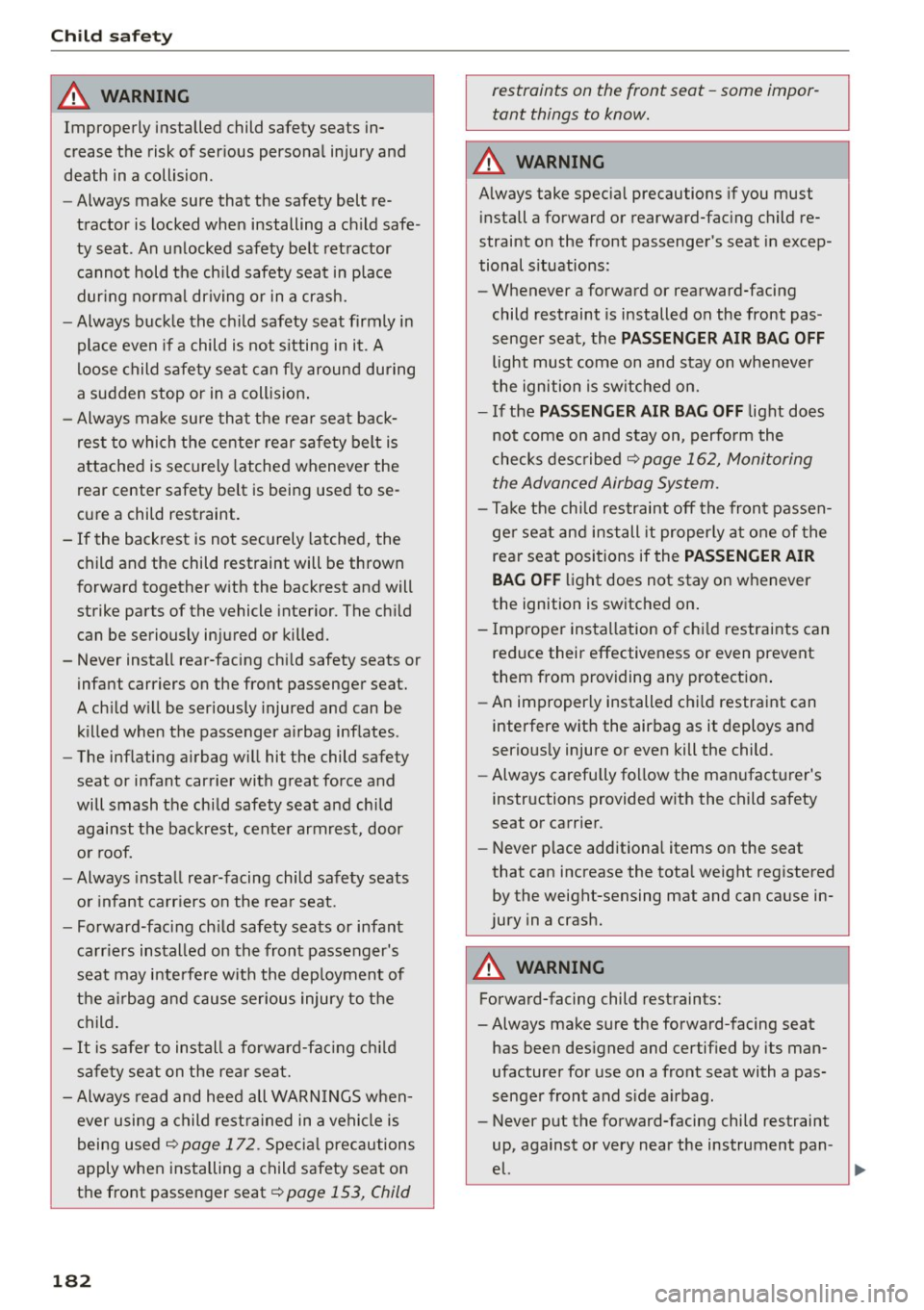
Child safety
A WARNING
Improperly installed child safety seats in
crease the risk of serious personal injury and
death in a collision.
- Always make sure that the safety belt re
tractor is locked when installing a child safe
ty seat . An unlocked safety belt retractor
cannot hold the child safety seat in place
during normal driving or in a crash.
- Always buckle the child safety seat firmly in
place even if a child is not sitting in it. A
loose child safety seat can fly around during
a sudden stop or in a collision.
- Always make sure that the rear seat back
rest to which the center rear safety belt is
attached is securely latched whenever the
rear center safety belt is being used to se
cure a child restraint.
- If the backrest is not securely latched, the
child and the child restraint will be thrown
forward together with the backrest and will
strike parts of the vehicle interior. The child
can be seriously injured or killed.
- Never install rear-facing child safety seats or
infant carriers on the front passenger seat.
A child will be seriously injured and can be
killed when the passenger airbag inflates .
- The inflating airbag will hit the child safety
seat or infant carrier with great force and
will smash the child safety seat and child
against the backrest, center armrest, door
or roof.
-Always install rear-facing child safety seats
or infant carriers on the rear seat.
- Forward-facing child safety seats or infant
carriers installed on the front passenger's
seat may interfere with the deployment of
the airbag and cause serious injury to the
child.
- It is safer to install a forward-facing child
safety seat on the rear seat.
- Always read and heed all WARNINGS when
ever using a child restrained in a vehicle is
being used
~page 172. Special precautions
apply when installing a child safety seat on
the front passenger seat~
page 153, Child
182
restraints on the front seat -some impor
tant things to know.
A WARNING
Always take special precautions if you must
install a forward or rearward-facing child re
straint on the front passenger's seat in excep
tional situations:
- Whenever a forward or rearward-facing
child restraint is installed on the front pas
senger seat, the
PASSENGER AIR BAG OFF
light must come on and stay on whenever
the ignition is switched on.
- If the PASSENGER AIR BAG OFF light does
not come on and stay on, perform the
checks described
~ page 162, Monitoring
the Advanced Airbag System.
-Take the child restraint off the front passen
ger seat and install it properly at one of the
rear seat positions if the
PASSENGER AIR
BAG OFF
light does not stay on whenever
the ignition is switched on.
- Improper installation of child restraints can
reduce their effectiveness or even prevent
them from providing any protection.
- An improperly installed child restraint can
interfere with the airbag as it deploys and
seriously injure or even kill the child .
- Always carefully follow the manufacturer's
instructions provided with the child safety
seat or carrier.
- Never place additional items on the seat
that can increase the total weight registered
by the weight-sensing mat and can cause in
jury in a crash.
A WARNING
Forward-facing child restraints:
-Always make sure the forward-facing seat
has been designed and certified by its man
ufacturer for use on a front seat with a pas
senger front and side airbag.
- Never put the forward-facing child restraint
up, against or very near the instrument pan
el.
-
.__ ________________ __J ...
Page 185 of 302
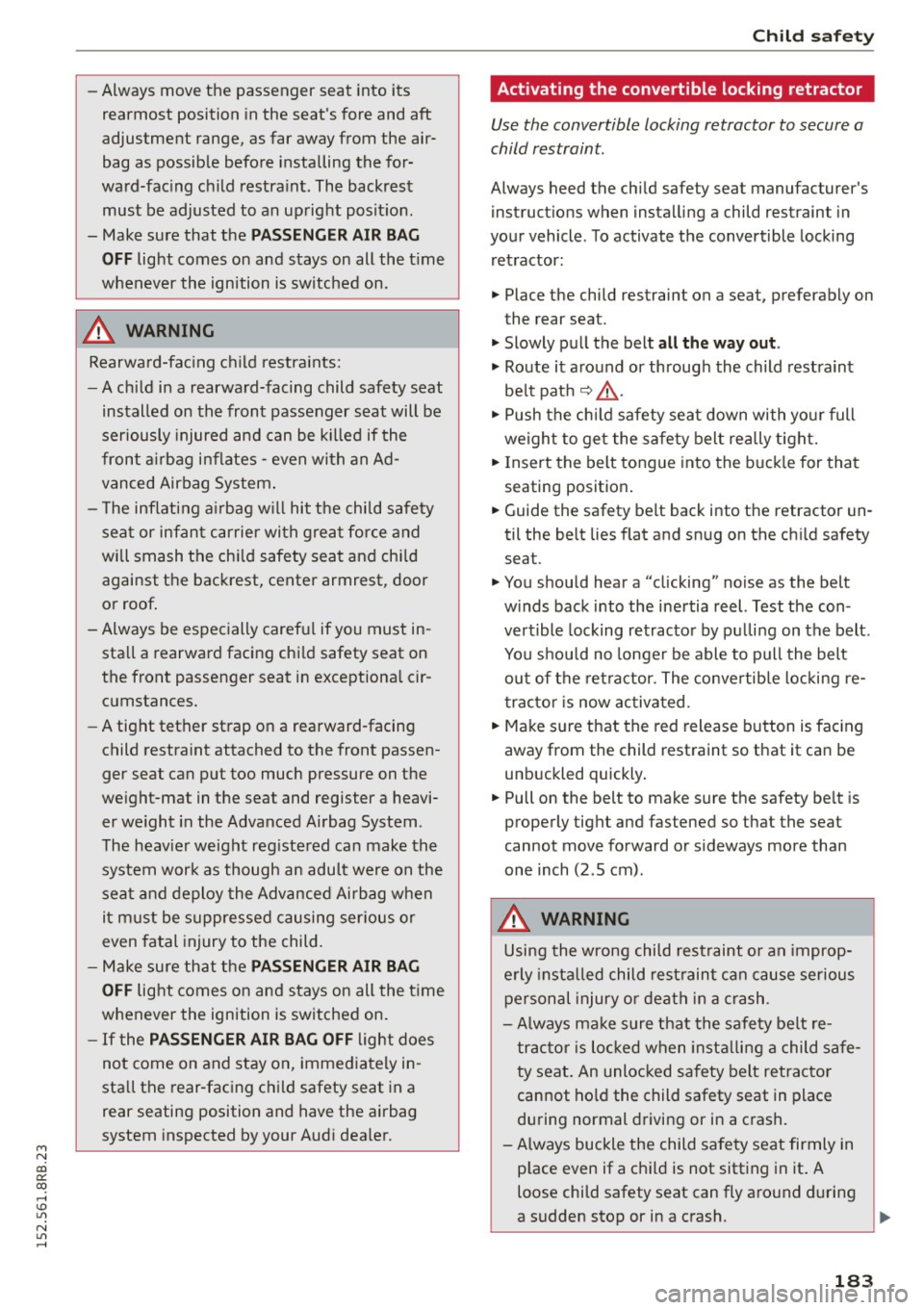
M N
co
a:
co
,...., \!) 1.1'1
N 1.1'1 ,....,
-Always move the passenger seat into its
rearmost position in the seat's fore and aft
adjustment range, as far away from the air
bag as possible before installing the for
ward-facing child restraint. The backrest must be adjusted to an upright position.
- Make sure that the
PASSENGER AIR BAG
OFF
light comes on and stays on all the time
whenever the ignition is switched on.
A WARNING
Rearward-facing child restraints:
-A child in a rearward-facing child safety seat
installed on the front passenger seat will be
seriously injured and can be killed if the
front airbag inflates - even with an Ad
vanced Airbag System.
- The inflating airbag will hit the child safety
seat or infant carrier with great force and
will smash the child safety seat and child
against the backrest, center armrest, door
or roof.
- Always be especially careful if you must in
stall a rearward facing child safety seat on
the front passenger seat in exceptional cir cumstances.
- A tight tether strap on a rearward-facing
child restraint attached to the front passen
ger seat can put too much pressure on the
weight-mat in the seat and register a heavi er weight in the Advanced Airbag System.
The heavier weight registered can make the
system work as though an adult were on the
seat and deploy the Advanced Airbag when
it must be suppressed causing serious or
even fatal injury to the child.
- Make sure that the
PASSENGER AIR BAG
OFF
light comes on and stays on all the time
whenever the ignition is switched on.
- If the
PASSENGER AIR BAG OFF light does
not come on and stay on, immediately in
stall the rear-facing child safety seat in a
rear seating position and have the airbag
system inspected by your Audi dealer.
Child safety
Activating the convertible locking retractor
Use the convertible locking retractor to secure a
child restraint .
Always heed the child safety seat manufacturer's
instructions when installing a child restraint in
your vehicle . To activate the convertible locking
retractor:
.. Place the child restraint on a sea t, preferably on
the rear seat.
.. Slowly pull the belt all the way out.
.. Route it around or through the child restraint
belt path
~ . & .
.. Push the child safety seat down with your full
weight to get the safety belt really tight.
.. Insert the belt tongue into the buckle for that
seating position.
.. Guide the safety belt back into the retractor un
til the belt lies flat and snug on the child safety
seat .
.. You should hear a "clicking" noise as the belt
winds back into the inertia reel. Test the con
vertible locking retractor by pulling on the belt .
You should no longer be able to pull the belt
out of the retractor. The convertible locking re
tractor is now activated .
.. Make sure that the red release button is facing
away from the child restraint so that it can be
unbuckled quickly.
.. Pull on the belt to make sure the safety belt is
properly tight and fastened so that the seat
cannot move forward or sideways more than
one inch (2 .5 cm) .
A WARNING
Using the wrong child restraint or an improp
erly installed child restraint can cause serious
personal injury or death in a crash .
- Always make sure that the safety belt re
tractor is locked when installing a child safe
ty seat. An unlocked safety belt retractor
cannot hold the child safety seat in place
during normal driving or in a crash.
- Always buckle the child safety seat firmly in place even if a child is not sitting in it. A
loose child safety seat can fly around during
a sudden stop or in a crash. ..,.
183
Page 186 of 302
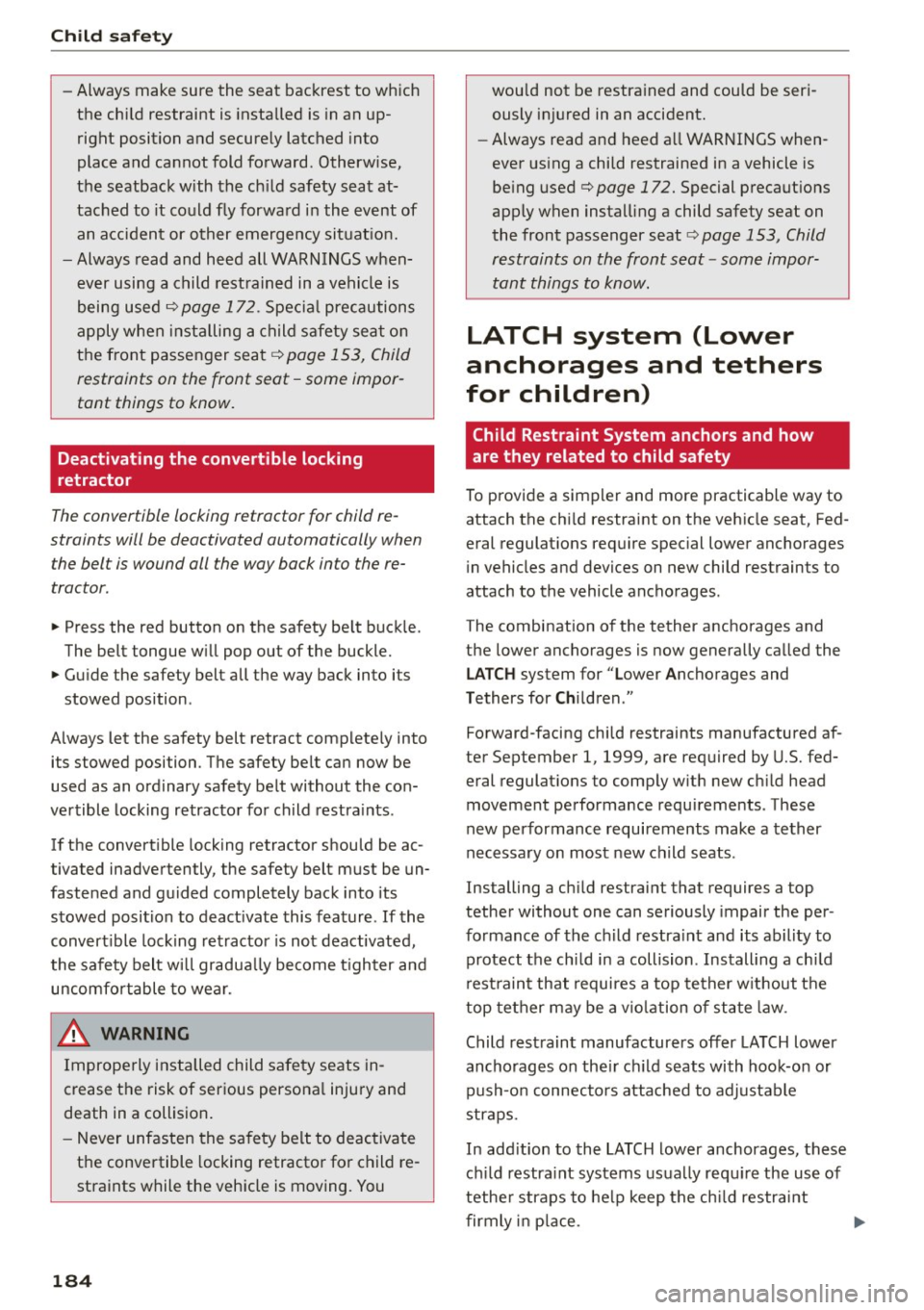
Child safet y
-Always make sure the seat backrest to which
the chi ld restraint is installed is in an up
right position and secure ly latched into
place and cannot fold forward. Otherw ise,
the seatback with the ch ild safety seat at
tached to it co uld fly forward in the event of
an accident or other emergency sit uat ion.
- Always read and heed all WARN INGS when
ever using a child restrained in a vehicle is
being used ¢
page 172. Special precautions
apply when installing a child safety seat on
the front passenger seat¢
page 153, Child
restraints on the front seat -some impor
tant things to know.
Deactivating the convertible locking
retractor
The convertible locking retractor for child re
straints will be deactivated automatically when
the belt is wound all the way back into the re
tractor .
~ Press the red button on the safety be lt buck le.
Th@ belt tongue will pop out of the buckle.
~ Guide the safety belt all the way back into its
stowed position .
A lways let the safety belt retract complete ly into
its stowed position . The safety belt can now be
used as an ordinary safety be lt without the con
vertible locking retractor for child restra ints .
If the convert ible locking retractor should be ac
tivated inadvertently, the safety belt must be un
fastened and guided completely back into its
stowed position to deact ivate this feature .
If the
convert ible locking retractor is not deactivated,
the safety belt wi ll gradua lly become t ighter and
uncomfo rtable to wear.
_& WARNING
Imprope rly installed child safety seats in
crease the risk of serious persona l injury and
death in a collision .
-
-Never unfasten the sa fety belt to deac tivate
the convertible locking retractor for child re
straints while the vehicle is moving. You
184
wou ld not be restrained and could be seri
ously inj ured in an accident.
- Always read and heed a ll WARNINGS when
ever us ing a child restrained in a vehicle is
be ing used
¢page 172. Special precaut ions
apply when installing a child safety seat on
the front passenger seat
r=> page 153, Child
restraints on the front seat -some impor
tant things to know.
LATCH system (Lower
anchorages and tethers
for children)
' Child Restraint System anchors and how
are they related to child safety
To provide a simpler and more practicable way to
attach the ch ild restraint on the vehicle seat, Fed
eral regulat ions require spec ial lower anchorages
i n vehicles and devices on new child restraints to
attach to the vehicle anchorages.
The combination of the tether anchorages and
the lower anchorages is now generally called the
LATCH system for " Lower Anchorages and
Tethers for C hildren ."
Forward-facing chi ld restraints manufactured af
ter September 1, 1999, are required by U.S. fed eral regulat ions to comp ly w ith new ch ild head
movement performance requirements . These
new performance requirements make a tether
necessary on most new child seats .
Installing a ch ild restraint that requires a top
tether without one can seriously impair the per
formance of the ch ild restra int and its ability to
protect the ch ild in a collision . Install ing a chi ld
r est raint that requi res a top tether w it h out t he
top tether m ay be a v io la tion of state law.
Child rest raint manufacturers offer LATCH lower
anchorages on the ir chi ld seats with hook-on or
push-o n connectors attached to adjustable
straps.
In add ition to the LATCH lower anchorages, these
c hi ld restra int systems usually requ ire the use of
tethe r straps to he lp keep the ch ild restrai nt
firmly i n place. .,.